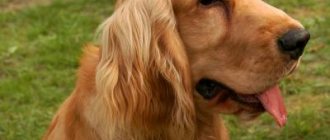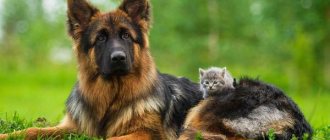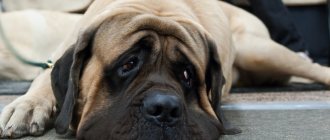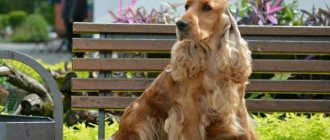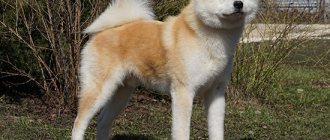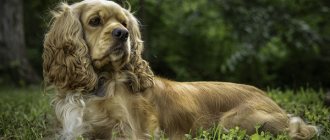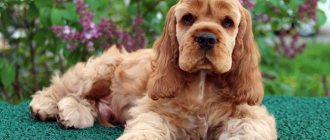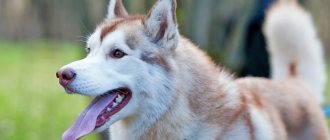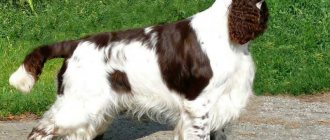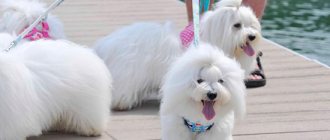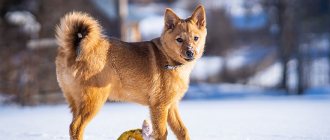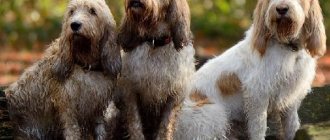Characteristics and breed standard
The English Cocker Spaniel is a small dog with well-developed muscles. The chest is wide, the legs are straight, of medium length, strong.
Height at withers: males 39-41 cm, females 37-39 cm Weight: 12.5-14.5 kg
Color: chocolate, black, gold, red, possible presence of tan marks. A white spot is allowed on the chest. There are two-color (black and white, lemon and white, chocolate and white, red and white with or without markings) or tri-color (black and white or chocolate and white with tan) spaniels. The common color is roan (roan-blue, chocolate-roan, roan-red, possible presence of tan marks).
- The dog's body is covered with soft, smooth, silky hair. On the hind legs the hair forms “pants”, on the muzzle and paws it is short. The length of the ears is continued by the long, straight coat.
- The nose is black, chocolate color is allowed if the coat color is chocolate or white-chocolate.
- The ears are long, hanging, low-set - the “calling card” of the spaniel.
- The tail is docked or naturally shaped and carried below the level of the back when the dog moves.
- The eyes are expressive, large, with a smart and at the same time playful expression.
- Eye color varies depending on coat color: brown, dark brown, hazel.
For clarity, we will show the differences in the exterior of the English and American Cocker Spaniel.
Breed description: standard
Hanging ears are one of the characteristic features of the breed
. According to the accepted standard, a brown or black spaniel has the following appearance features:
- head - round, dome-shaped;
- teeth and jaw – scissor bite, teeth small and quite strong;
- nose - the nasal lobe is quite large, painted black;
- eyes are large and round in shape, colored brown and sometimes blue;
- ears are quite long, hanging along the muzzle;
- neck - long, with well-developed muscles;
- the body is muscular, slightly elongated forward;
- limbs are not very long, have strong bones and good muscles;
- tail - set high, located slightly above the back;
- coat and color - spaniels have a curly coat, often black-brown with red tan.
Additional Information! Representatives of this breed have disqualifying defects. These include unusual speckled coat color, harelip, and excess weight.
History and description of the breed
The homeland of the English Cocker Spaniel is England, although its ancestors were brought from Spain - hence the name “spaniel”. But there are also opponents of this theory, who claim that cockers appeared in England, and Spain has nothing to do with it. The second part of the breed’s name is “cocker”, translated from English as “woodcock”.
Possessing a keen sense of smell, quickly moving through thickets and skillfully spooking game, spaniels have won the attention and love of hunters. They were used in falconry hunting game with a net - the dog crawled close to the bird and lay down, the falcon did not allow the bird to fly, and the hunter covered the cocker and the game with the net. Spaniels are excellent swimmers and can retrieve wounded birds from the water , and therefore are suitable for gun hunting.
Purposeful selection began in the 19th century, by which time two types of spaniels had emerged: springers and cockers. The ancestor of the English cockers is considered to be a dog named Obo . The first exhibition at which the breed was demonstrated took place in 1859. The Fédération Cynologique Internationale recognized the English Cocker Spaniel as a breed in 1974.
It is interesting that in the first years of the breed’s existence, only dogs weighing up to 11 kg were recognized as purebred; over time, the standard changed.
Cocker spaniel price
Cocker spaniel puppies with a pedigree and no defects (breeding) cost about 20,000 rubles. The minimum level is 13,000, the maximum is 40,000. The cost depends on the ambitions of the breeders, their popularity in dog breeding circles.
English Cocker Spaniel puppies
The price is also influenced by the characteristics, grades and titles of the puppies’ parents, and the origin of the adult dogs. For example, foreign individuals are often purchased. It is customary to ask for more for the offspring of such people, because it is necessary to “recoup” the cost of the foreign acquisition.
Puppies without a pedigree, on average, cost about 6,000. A Cocker Spaniel, whose price is lower, should be wary. There are offers for 3,000, but, as a rule, the latter hide animals with obvious flaws. They also ask very cheaply for crossbreds whose only one parent is a purebred spaniel.
Character and temperament
The English Cocker is an energizer whose tail wags non-stop. He loves to be the center of attention, is sociable and dependent on people. It is not recommended to leave dogs alone - loneliness is fraught with disturbances in the psycho-emotional state and the appearance of behavioral problems.
Pros:
- good hunter;
- brave and resilient;
- playful;
- smart;
- affectionate and devoted;
- distrustful of strangers.
Minuses:
- overly active;
- easy to spoil;
- prone to loud barking.
English cocker spaniel and man
This is a tireless hunter, a wonderful friend and companion. He is devoted to his owner and is ready to follow him to the ends of the earth. Thanks to its compact size and easy care, an Englishman feels good both in a country house and in a city apartment, provided there are active walks, activities, and communication with the owner. It is not advisable for older people and those who do not like active recreation to have a spaniel.
The spaniel cannot act as a full-fledged guard, but it makes a good “bell” - this breed is prone to loud barking with or without reason, and will warn you of the approach of a suspicious stranger.
This is a tireless friend for children . He is patient with little ones and will not bite a child. The main thing is to ensure that children do not torture the dog. The cocker is “for anything except a hunger strike” and happily joins in outdoor games with children - catching up, fetching the ball, hide and seek.
He is patient with other pets, but can also get into conflict with a cat or other dog.
Maintenance and care
An Englishman does not need a lot of space to live, so he lives comfortably even in a small one-room apartment . The main condition for keeping a dog is constant communication with a person, and therefore it is impossible to keep a spaniel in an enclosure . In addition, living on the street is contraindicated for him: in the cold season he will freeze and catch a cold.
If the cocker does not realize his seething energy, chewed furniture and howling under the door are guaranteed.
walk your dog at least 2 times a day , but it doesn’t hurt to make one walk 2 hours long and include a jog. Use your pet’s sharp mind and hunting instincts in sports competitions, which he will be delighted to attend. Obedience, agility, freestyle - he has no equal here. If you can visit bodies of water during the warm season, you will make your dog happy - the love of swimming among cockers is inherited.
Feeding
The dog is active and needs high-calorie . The diet should contain lean meat (beef, horse meat), boiled offal (heart, lungs, liver), fish taken from the bones (cod). It is useful to add vegetables (carrots, cucumbers), herbs and fruits, except citrus fruits, to the bowl. A cocker will not refuse buckwheat or oatmeal, but still the majority of the portion should be meat. Periodically treat your pet with cottage cheese or kefir.
The portion of a working or sports dog should replenish the energy expended, and therefore it should be increased compared to the portion of a companion dog.
If you feed your pet dry food, do not mix it with natural food - this will harm your pet's health. Food is offered 2 times a day.
Grooming and cutting
The wool requires regular brushing with a soft brush, otherwise it will become tangled and create tangles. Bath the dog as it gets dirty, but at least 3-4 times a year. The hair in the area of the paw pads and between the toes is trimmed. Dogs are also shorn/trimmed before the show. Grooming an animal is a responsible matter, entrust it to a professional.
Ears should be cleaned periodically with a cotton swab to avoid wax buildup and disease.
The eyes are wiped as necessary with a cotton swab soaked in tea solution, and the claws are cut if they do not grind off naturally.
Features of care
Combing
The Cocker needs to be brushed 3-5 times a week. a furminator for this .
Caring for an English Spaniel includes monthly bathing procedures using special products (shampoos, conditioners, etc.).
Make sure that the latter have antistatic properties.
A baby spaniel should have its first haircut around the age of two months, then every 2-3 months you should take your dog to a professional.
This article will tell you how to cut a dog’s hair at home.
Illiterate grooming can distort a dog’s appearance beyond recognition, so don’t be tempted by the low prices of amateurs.
The English Cocker Spaniel is very fond of fashionable hairstyles - after all, this is one of his main advantages.
The claws are trimmed as they grow, and along with this procedure, the hair on the paw pads between the toes must also be trimmed.
Once a week, inspect and wash the ears, and remove plaque.
It is necessary to monitor your eyes daily; after sleep, mucus may form in them, which is removed with a clean napkin.
Walk
No matter how much you walk with the spaniel, it will not be enough for him. Therefore, in this matter, the more often the better.
You can do it a couple of times a day for an hour - good, 3-4 times - even better!
Walks should combine active games like agility and elements of training .
The Cocker Spaniel can actively play outside in any weather conditions.
Nutrition
Diet by age:
- up to 2 months fed 6 times a day;
- from 2 to 4 – 5 times;
- from 4 to 6 – 4 times;
- from 6 to 10 – 3 times;
- from 10 months onwards – 2-3 times, depending on physical activity.
The diet should contain the following products:
- Beef scalded with boiling water.
- Boiled by-products.
- Boiled sea fish from which the bones have been previously removed.
- Fermented milk products - kefir, cottage cheese, yogurt.
- Soft-boiled eggs.
- Bread and cereals - any kind in small quantities. An exception is that puppies should not be given pearl barley porridge, it irritates their stomach.
- Vegetables and herbs – finely chopped and mixed with vegetable oil or low-fat sour cream.
- Raisins, cheese, dried fruits - give as a treat.
The animal can be given premium dry food .
The cocker spaniel swims very beautifully and quietly, it seems that the dog makes no effort at all
Under no circumstances should a spaniel be allowed on the menu:
- Bones - do not carry nutritional value and can injure the esophagus and damage the dog’s intestines.
- Very hot or too cold food.
- Salty, fatty, spicy, smoked, sausages, sausages and the like.
- Candy, cookies and other sweets, especially for puppies.
- River fish.
- Pork, fatty lamb and fresh chicken.
The English Cocker Spaniel has a good appetite; owners should ensure that the dog does not overeat, otherwise it will become very obese.
If the dog is capricious and refuses to eat what is given for 1-2 days, you don’t have to worry about it; a little fasting will never hurt your spaniel.
Especially if the dog remains active and cheerful.
The Cocker Spaniel is a little glutton who always wants something to eat.
Training and education
English cockers are highly intelligent and a pleasure to train. They are ready to serve the owner, so even a beginner can raise a dog.
It is better to organize training in the form of games using positive reinforcement; harshness is acceptable only in minimal quantities (do not confuse it with cruelty), since these dogs are prone to dominance.
Training a hunting spaniel will be useful not only for hunting, but also for participation in hunting competitions. Full training begins when the puppy is 6-8 months . But there are also exercises that are practiced when the puppy is still small. To begin with, the dog’s ability to catch odors is developed using the upper sense.
Description of the exercise: place a piece of treat at a height of up to 1.5 m and give the dog the “search” .
The training lasts one hunting season. During this time, the dog learns to find and pick up game, and after that, not to chase and lie down, giving the hunter the opportunity to shoot. After the shot, the dog goes for the game carcass and brings it to the owner.
History of the origin of the breed
The modern cocker spaniel breed descends from a large group of spaniels that lived many centuries ago. It is believed that the breed first appeared in Spain, and by the beginning of the 19th century they were divided into two separate categories. The first category included decorative cockers, and the second included hunting ones, which were divided into water and land ones.
Cockers are distinguished from other dog breeds by their impressive appearance.
Only towards the end of the 19th century were cockers recognized as an independent breed and began to be actively bred in UK nurseries. Charming cocker spaniels almost instantly won the sympathy of numerous breeders and dog lovers.
Health and life expectancy
Representatives of the breed live 12-15 years .
English cockers are gentle dogs, although they have strong immunity. They are susceptible to the following diseases:
- eye diseases (cataracts, conjunctivitis, glaucoma, entropion, retinal atrophy);
- otitis;
- urolithiasis disease;
- food allergies;
- hip dysplasia;
- hypothyroidism;
- hepatitis.
Breed photo
A selection of photos of an English spaniel.
Add a comment Cancel reply
